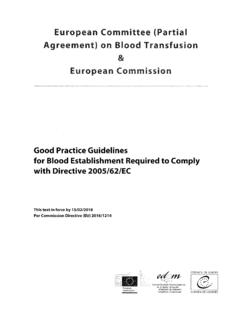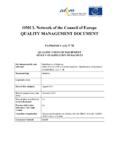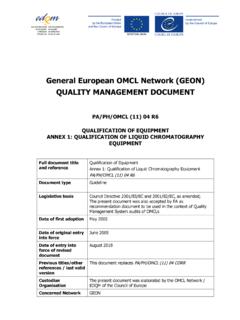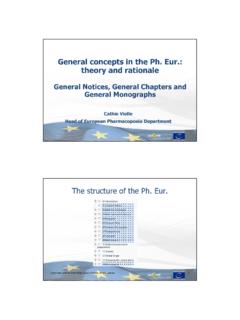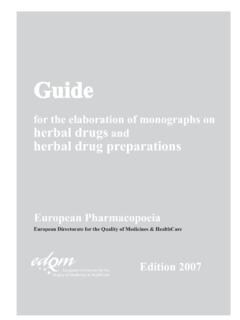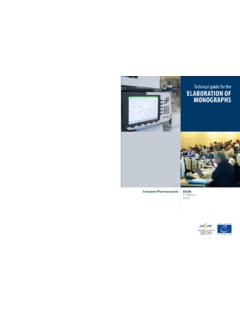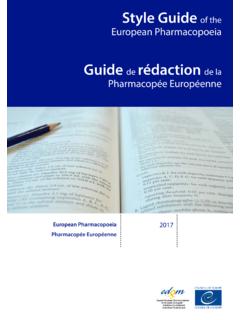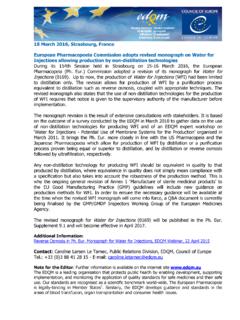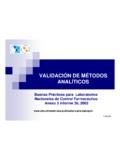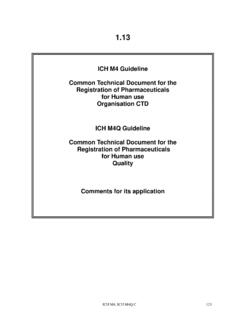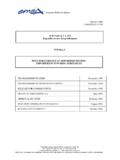Transcription of OMCL Network of the Council of Europe GENERAL …
1 OMCL Network of the Council of Europe GENERAL DOCUMENT PA/PH/OMCL (13) 82 2R validation OF analytical PROCEDURES Full document title and reference validation of analytical Procedures PA/PH/OMCL (13) 82 2R Document type Guideline Legislative basis The present document was also accepted by EA as recommendation document to be used in the context of Quality Management System audits of OMCLs Date of first adoption October 1999 Date of original entry into force February 2000 Date of entry into force of revised document February 2014 Previous titles/other references This document replaces document PA/PH/OMCL (05) 47 DEF Former titles/references: PA/PH/OMCL (99) 37 DEF Custodian Organisation The present document was elaborated by the OMCL Network / EDQM of the Council of Europe Concerned Network GEON PA/PH/OMCL (13) 82 2R 2/9 validation OF analytical PROCEDURES GUIDELINE FOR OMCLs INTRODUCTION The two ICH guidelines on validation of analytical Procedures: Definition/ Terminology and Methodology (Q2A and Q2B) constitute a discussion of the validation characteristics that should be considered during the validation of an analytical procedure (the guideline has also been adopted for veterinary products during VICH discussion).
2 They are primarily addressed to pharmaceutical industry indicating which validation data need to be provided in an application file. These data should demonstrate that the proposed testing and acceptance criteria are sufficiently under control to guarantee reproducible quality of the products at release and adequate control during shelf-life (stability). As the circumstances under which an OMCL works are different from those of a pharmaceutical company in most cases no routine analysis, but often responses to be made in a short period of time -, the extent of analytical validation requested before performing an analysis needs to be reconsidered. On the other hand it has in all cases to be guaranteed that the result submitted is reliable.
3 It should also be emphasised here, that adequate reference materials are an important factor in both the performance of the validation studies and the analysis it-self. The use of widely accepted reference preparations can in certain circumstances avoid the consideration of some validation characteristics, mainly in the field of biological products: this has then to be justified on a case by case basis. The scope of this document specifically addressed to OMCLs - is to give guidance on the extent of validation needed, depending on various circumstances objective of the analysis ( screening for non compliance), amount of validation data already available ( in case of a method transfer), experience or historical data already available in the individual OMCL ( recovery from a complex matrix; routine use of a standard titration even if different substances are titrated), etc.
4 This document is equally applicable to products of synthetic and of biological origin. It does not address common laboratory practice: for instance specific use of the equipment, calibration etc. This document is a note for guidance, which provides detailed recommendations of the extent of the validation exercise dependent on the category of the analytical procedure; it should be noted that other approaches are always possible. With respect to the new Directive 2010/63/EU on ethical animal use for scientific and educational purposes and the European Convention for the Protection of Vertebrate Animals used for Experimental and Other Scientific Purposes ( Council of Europe ) special attention is needed for the use of in vivo methods as analytical procedures.
5 All efforts should be made to rationalise and restrict animal use to a necessary minimum based on a thorough analysis of the particular situation. It should be stressed that this document cannot provide detailed advice for all possible cases where in vivo tests are used. The purpose of this document is to provide GENERAL guidance. 3/9 PA/PH/OMCL (13) 82 2R In all cases a short description and/or justification of the approach chosen, including the methods, should be described in the internal documentation of the analysis. validation data of validated methods (compendial, marketing authorisation dossier) should be available.
6 Modifications from the original validated method should be justified. The same definitions as in the ICH document apply. CATEGORIES OF ANALYSIS This chapter defines the different analytical situations (categories) which might occur in an OMCL and the corresponding validation characteristics which should be considered. (As a reminder the table in the annex describes in GENERAL the validation characteristics to be considered, depending on the different types of analytical procedures). Formal validation studies, according to the ICH requirements, has to be performed for a new developed method or when for an existing method the validation data have to be completed. Method transfer check (verification of suitability) has to be done to show that under actual conditions of use in the individual laboratories the method is adequate (fit for use).
7 This might imply for instance the carrying out of the system suitability tests ( resolution in a chromatographic method), the control of the reporting threshold, the control of the completeness of a reaction step ( extraction, hydrolysis reaction) before the actual determination can be performed, the verification of the precision of the method etc. So for instance the system suitability tests described in a fully validated liquid chromatography method will in all cases have to be performed, as these tests are part of the analytical procedure. This is particular true for the category Transfer of a method . In all cases, a short note, explaining the rational for the chosen approach -depending on the complexity of the analysis required-, will have to be provided in the internal documentation of the analysis.
8 Deviation from this guideline should be justified. The following categories of analysis are considered: - Transfer of a method - Screening - Development of a new analytical procedure 1. Transfer of a Method In this category it is assumed that a certain amount or elements of validation data for this particular analysis is already available: so no or only a few validation characteristics need to be considered. In an ideal situation, this can also be done by comparison of the results of two laboratories performed on the same sample. No formal validation required indicates that the respective validation characteristics have already been considered by others. However a verification of suitability under conditions of use (=method transfer check) has to be done in all cases by the OMCL.
9 PA/PH/OMCL (13) 82 2R 4/9 Pharmacopoeial (compendial) method Active substance The analytical procedures described in a monograph of a pharmacopoiea are considered to be validated. In this case it should be made sure that all reference materials needed are available and the required system suitability tests are performed. Nevertheless, it should also be considered that a pharmacopoeial monograph is only considered validated (related substances test) when it is applicable to the control of the listed impurities (specific source material, see Ph Eur). Identification: no formal validation required; Testing for Impurities: no formal validation required; Assay: no formal validation required. Note: To fall under this category, the procedures must be described in detail, not for instance as in some cases for biologicals where there is only a GENERAL description of the method.
10 The details may come from the published report of the collaborative study (eg. BSP study reports in Pharmeuropa Bio & Scientific notes) Medicinal product The pharmacopoeial monograph for a specific dosage form is a good basis for the analysis; however as in many cases there is no indication about the exact composition of the product (qualitative and quantitative composition of the excipients), it must at least be made sure that these do not interfere in the analysis of the active substance, unless addressed in the monograph. - Identification: no formal validation required; - Testing for Impurities: specificity: no interference from excipients; reporting threshold (at least the ) - Assay: specificity, accuracy: mainly recovery, minimum 1 determination.
